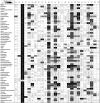Development of the Korean construction job exposure matrix (KoConJEM) based on experts' judgment using the 60 consolidated occupations for construction workers
- PMID: 38536905
- PMCID: PMC11033576
- DOI: 10.1093/annweh/wxae017
Development of the Korean construction job exposure matrix (KoConJEM) based on experts' judgment using the 60 consolidated occupations for construction workers
Abstract
Background: This study was conducted as an effort to develop a Korean construction job exposure matrix (KoConJEM) based on 60 occupations recently consolidated by the construction workers mutual aid association for use by the construction industry.
Methods: The probability, intensity, and prevalence of exposure to 26 hazardous agents for 60 consolidated occupations were evaluated as binary (Yes/No) or four categories (1 to 4) by 30 industrial hygiene experts. The score for risk was calculated by multiplying the exposure intensity by the prevalence of exposure. Fleiss' kappa for each hazardous agent and occupation was used to determine agreement among the 30 experts. The JEM was expressed on a heatmap and a web-based dashboard to facilitate comparison of factors affecting exposure according to each occupation and hazardous agent.
Results: Awkward posture, heat/cold, heavy lifting, and noise were hazardous agents regarded as exposure is probable by at least one or more experts in all occupations, while exposure to asphalt fumes was considered hazardous in the smallest number of occupations (n = 5). Based on the degree of agreement among experts, more than half of the harmful factors and most occupations showed fair to good results. The highest risk value was 16 for awkward posture for most occupations other than safety officer.
Conclusions: The KoConJEM provides information on the probability, intensity, and prevalence of exposure to harmful factors, including most occupations employing construction workers; therefore, it may be useful in the conduct of epidemiological studies on assessment of health risk for construction workers.
Keywords: intensity; prevalence; probability; risk.
© The Author(s) 2024. Published by Oxford University Press on behalf of the British Occupational Hygiene Society.
Conflict of interest statement
The authors declare no conflict of interest.
Figures





References
-
- Altman DG. Practical statistics for medical research. New York: CRC press; 1990
-
- Berrino F, Richiardi L, Boffetta P, Estéve J, Belletti I, Raymond L, Troschel L, Pisani P, Zubiri L, Ascunce Net al. .; Milan JEM Working Group. Occupation and larynx and hypopharynx cancer: a job-exposure matrix approach in an international case–control study in France, Italy, Spain and Switzerland. Cancer Causes Control: CCC 2003:14(3):213–223. 10.1023/a:1023661206177 - DOI - PubMed
-
- Choi SD, Guo L, Kim J, Xiong S.. Comparison of fatal occupational injuries in construction industry in the United States, South Korea, and China. Int J Ind Ergon. 2019:71(1):64–74. 10.1016/j.ergon.2019.02.011 - DOI
Publication types
MeSH terms
Substances
Grants and funding
LinkOut - more resources
Full Text Sources
Medical
